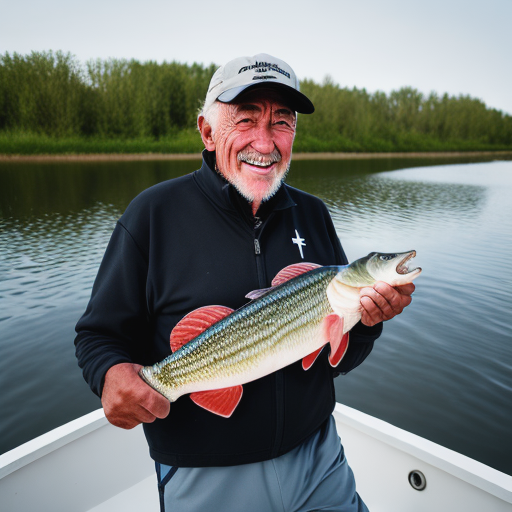Welcome to our guide on lake trout depth preferences! If you’re an angler looking to improve your chances of catching lake trout, understanding their preferred depth can make all the difference. Lake trout are renowned for their size, strength, and delicious taste, making them a popular target for fishing enthusiasts.
Lake trout thrive in deep, cold-water lakes found in Northern states, certain Western states, and Canada. These cold-water fish prefer specific depths that provide them with the right conditions for feeding and survival. By knowing their ideal depth, you can increase your chances of hooking one of these prized fish.
Throughout this article, we will explore the preferred depth of lake trout in different seasons, the best techniques for catching them, and the gear you’ll need to maximize your success. So, let’s dive in and discover the ideal waters where lake trout reside!
Key Takeaways:
- Lake trout prefer deep, cold-water lakes in Northern states, certain Western states, and Canada.
- Understanding the preferred depth of lake trout can improve your chances of success.
- Different seasons require different depths and fishing techniques for targeting lake trout.
- Equip yourself with the right gear and adapt to changing conditions to increase your chances of catching lake trout.
- Catching lake trout can provide an enjoyable and rewarding fishing experience for anglers.
Best Times to Catch Lake Trout: Spring, Summer, and Fall
When it comes to lake trout fishing, timing is everything. Knowing the best times to cast your line can significantly increase your chances of landing a trophy-sized catch. According to fishing expert Jeremy Smith, there are three prime seasons for targeting lake trout: early spring, summer months, and fall.
Early Spring:
During early spring, as the ice melts and temperatures begin to rise, lake trout become more active in their search for food. This is an opportune time to focus on shallow, warmer water areas where the food chain is active. The resurgence of life in the water leads to increased feeding activity among lake trout, making them more willing to strike your bait. This is the ideal season to target lake trout near shorelines and shallower depths.
Summer Months:
The summer months provide another excellent opportunity for lake trout fishing. During this time, lake trout can be found in deep basins, relating to points, humps, and bottom transitions. By locating these underwater structures, anglers can increase their chances of encountering schools of lake trout. While they may retreat to deeper waters, they are still actively feeding and can be enticed by various lures and presentations.
Fall:
Fall is another prime season for lake trout fishing, especially when targeting spawning shoals. As lake trout prepare for their annual spawning ritual, they congregate near shallow shoals found in depths of 10 to 20 feet. This provides a unique opportunity to catch lake trout in shallower waters, where they are more accessible to anglers. By focusing on these areas during the fall, you can capitalize on the feeding frenzy and increase your chances of a successful fishing trip.
By understanding the best times to catch lake trout, you can plan your fishing outings accordingly and maximize your chances of a successful day on the water. Whether you prefer the excitement of spring fishing, the depths of summer, or the autumnal beauty of fall, there’s a season that suits every angler’s preference.
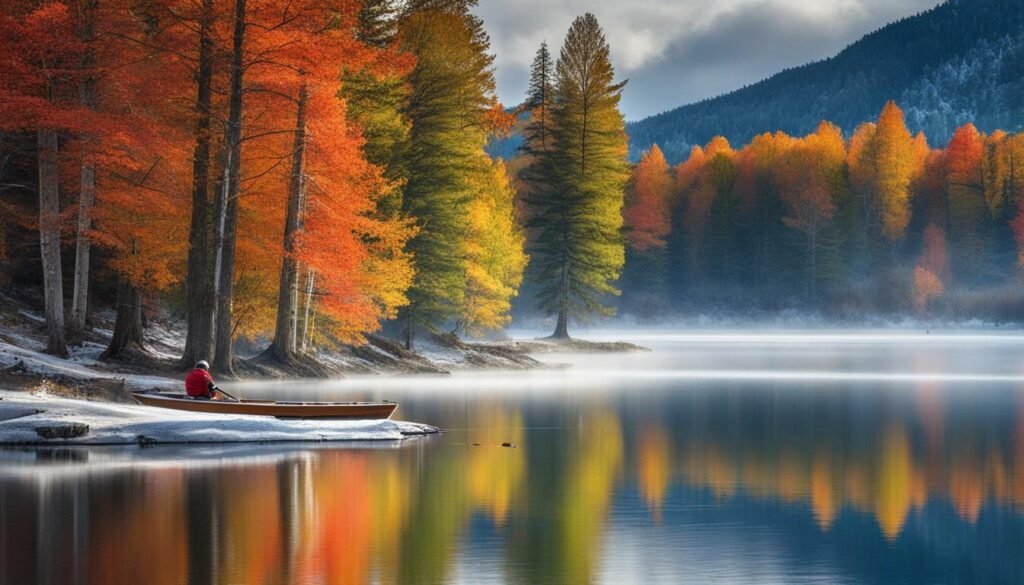
Stay tuned for the next section, where we will explore specific tactics and techniques for lake trout fishing in each of these seasons!
Spring Fishing Tactics for Lake Trout
When it comes to lake trout fishing in spring, trolling is a highly effective technique. In the early spring months, anglers should focus on targeting lake trout in shallow, warmer water areas where they are likely to be found. These areas include neck-downs, sections with current, deep ditches leading into backwater bays, and island complexes adjacent to shallow water.
A key aspect of successful spring fishing for lake trout is using the right bait. Shad-style crankbaits and thick-bodied spoons are highly recommended for trolling in early spring. These types of baits mimic the natural forage of lake trout, thereby increasing the chances of attracting and enticing them to strike.
When selecting a crankbait or spoon, opt for bright and vibrant colors that can enhance visibility in the slightly murky waters of early spring. Experiment with different depths and speeds while trolling to find the most effective presentation for enticing lake trout to bite. Remember, lake trout are known for their aggressive nature, so don’t be afraid to vary your trolling speed and action to trigger a strike.

Mastering the art of spring trolling for lake trout can open up incredible opportunities for anglers. Not only is it a thrilling experience to feel the powerful strike of these hard-fighting fish, but it also provides a chance to enjoy the beauty of nature as spring starts to unfold.
Spring Fishing Tactics Summary:
- Troll in shallow, warmer water areas
- Target neck-downs, areas with current, deep ditches leading into backwater bays, and island complexes adjacent to shallow water
- Use shad-style crankbaits and thick-bodied spoons
- Opt for bright and vibrant colors
- Experiment with different depths and speeds
By following these tactics and adapting to the specific conditions of each fishing spot, anglers can enhance their chances of hooking into some impressive lake trout during the spring season.
| Tactic | Description |
|---|---|
| Trolling | Fishing method where bait is pulled behind a moving boat |
| Shallow, warmer water | Fish in areas where lake trout and baitfish are likely found |
| Neck-downs | Sections of a lake where the width narrows |
| Areas with current | Flowing water attracts baitfish and lake trout |
| Deep ditches leading into backwater bays | Transition areas where lake trout often patrol |
| Island complexes adjacent to shallow water | Lake trout use islands as feeding and hiding spots |
| Shad-style crankbaits | Baits that mimic the natural forage of lake trout |
| Thick-bodied spoons | Spoon-shaped baits with a thicker profile |
Summer Fishing Tactics for Lake Trout
In the summer months, lake trout can be found in deep basins within 80 to 120 feet of water. To increase your chances of success, anglers can employ various fishing techniques, including vertical jigging and trolling.
Vertical Jigging for Lake Trout in Summer
Vertical jigging is a highly effective technique for targeting lake trout during the summer. This method involves dropping a weighted lure straight down into the water column and imparting an enticing action to attract the fish.
“Vertical jigging allows you to precisely control the depth and movement of your lure, increasing your chances of enticing a strike from lake trout,” says fishing expert Jeremy Smith.
When vertical jigging for lake trout in the summer, it is essential to use the right lures and equipment. Blade baits, Jigging Raps, heavy jigging spoons, tubes, and fluke-style plastics are excellent choices, as they mimic the natural prey of lake trout.
Remember to vary your jigging technique by using short, sharp jerks or long, sweeping motions to imitate the movement of injured baitfish. This variance in action can trigger the predatory instincts of lake trout and entice them to strike.
Trolling for Lake Trout in Summer
Trolling is another effective technique for summer lake trout fishing. It allows you to cover more water and target suspended lake trout.
“Trolling with spoons and wide-action crankbaits can help you locate active lake trout and trigger strikes,” recommends Jeremy Smith. “Experiment with different speeds and lure colors until you find what the fish are responding to.”
When trolling, pay attention to your depth and speed. Lake trout in the summer are often found deep, so adjust your trolling speed and use downriggers or lead-core lines to reach the desired depth.
Here’s a comprehensive breakdown of the gear and techniques for vertical jigging and trolling for lake trout in summer:
| Technique | Gear | Technique Tips |
|---|---|---|
| Vertical Jigging | – Medium or medium-heavy spinning rod – Spinning reel with smooth drag system – 10 to 20-pound test braided line – 12 to 15-pound fluorocarbon leader – Blade baits, Jigging Raps, heavy jigging spoons, tubes, fluke-style plastics |
– Vary jigging cadence and retrieve speed – Pay attention to depth and adjust lure weight accordingly – Use sonar or fish finders to locate suspended lake trout |
| Trolling | – Medium trolling rod – Level wind reel with line counter – 15 to 30-pound test monofilament or braided line – Downriggers or lead-core lines – Trolling spoons, wide-action crankbaits |
– Vary trolling speed and lure color – Use downriggers or lead-core lines to reach desired depth – Cover a range of depths and areas to locate active lake trout |
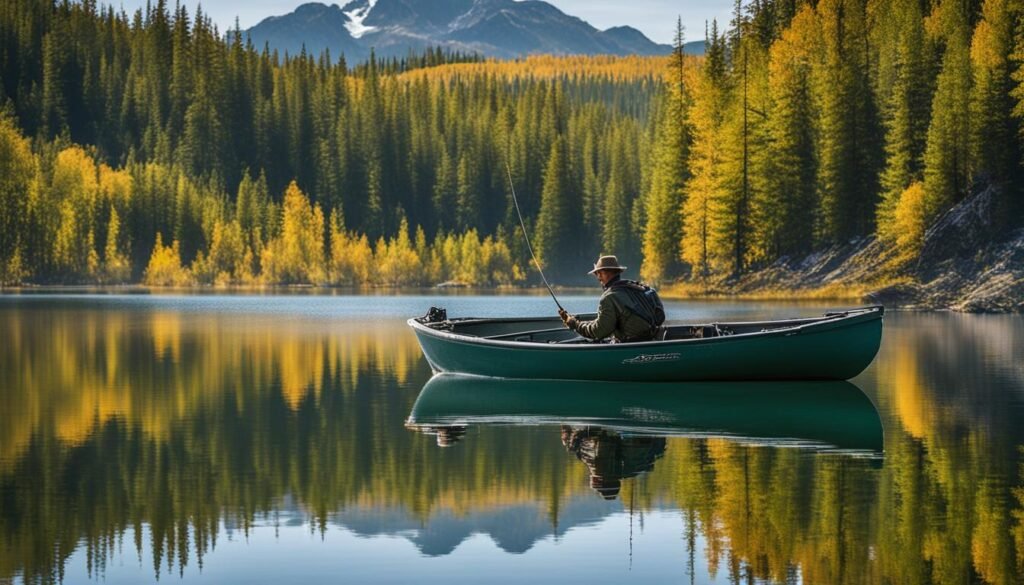
Fall Fishing Tactics for Lake Trout
During the fall season, lake trout enter the prespawn stage, making it an ideal time for fishing enthusiasts to target these impressive fish. One effective strategy is to focus on shoals where lake trout gather to spawn, typically found in 10 to 20 feet of water.
For fall fishing, there are several recommended baits that can entice lake trout to strike. Rattling lipless crankbaits are a popular choice due to their ability to create enticing sound vibrations in the water. Plastic swimbaits on jigs are also effective, as they mimic the appearance and movement of baitfish. Additionally, spoons, known for their flashing and wobbling action, can attract lake trout in the fall.
This season offers a unique advantage to anglers as lake trout become less selective in their feeding. It provides an exciting opportunity to experiment with different presentations, techniques, and lure colors to find what works best. Whether it’s a steady retrieve, pauses, or erratic movements, varying your bait’s action can trigger strikes from these aggressive fish.
Expert Tip:
“When fishing for lake trout in the fall, consider using a combination of rattling lipless crankbaits, plastic swimbaits, and spoons to maximize your chances of success. Don’t be afraid to experiment with different colors and retrieve speeds to find the winning formula.”
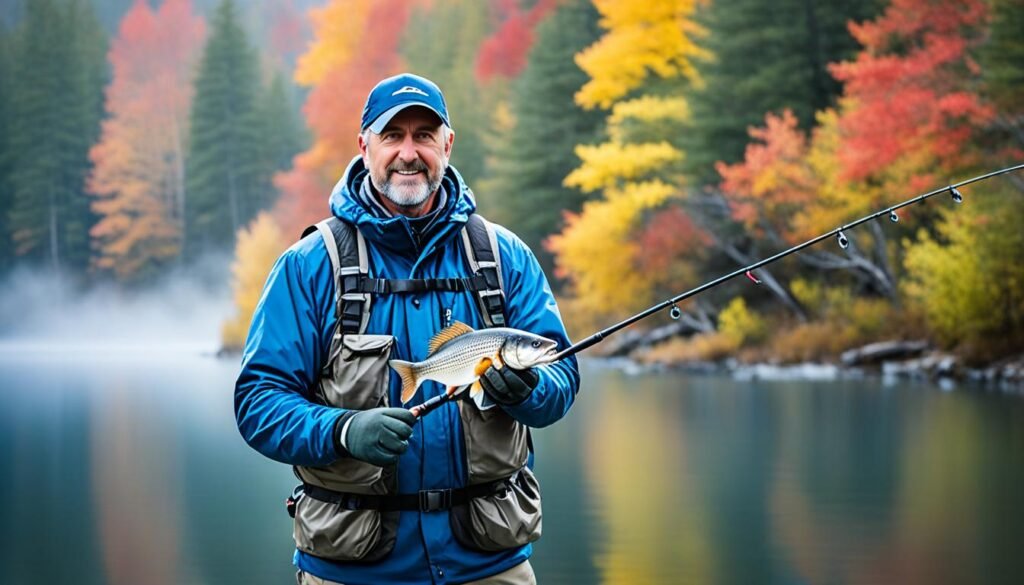
| Bait Type | Description |
|---|---|
| Rattling Lipless Crankbaits | Creates enticing sound vibrations in the water to attract lake trout |
| Plastic Swimbaits on Jigs | Mimics the appearance and movement of baitfish |
| Spoons | Flashing and wobbling action that entices lake trout to strike |
Tips for Gear and Equipment for Catching Lake Trout
When it comes to lake trout fishing, having the right gear and equipment is essential for a successful and enjoyable experience. Whether you’re targeting lake trout weighing anywhere from 2 to 20 pounds or hoping to land a trophy-sized catch, here are some recommended gear and equipment options to consider:
Fishing Rod:
A 7- to 8-foot-long, medium or medium-heavy fishing rod is ideal for lake trout fishing. Look for rods with responsive tips and good flex through the midsection. These features help cushion the fight and ensure that hooks stay securely pinned during intense battles.
Fishing Reel:
Invest in a quality fishing reel that can handle the power and strength of lake trout. Spool the reel with 15- to 30-pound-test braided line, providing the necessary strength to handle the fight. Braided line offers low stretch, excellent sensitivity, and increased hook-setting power.
Leader Material:
Attach a 14-pound-test fluorocarbon leader material to your mainline to prevent bite-offs from the sharp teeth of lake trout. Fluorocarbon is highly invisible underwater and has excellent abrasion resistance, making it an ideal choice for targeting these wily fish.
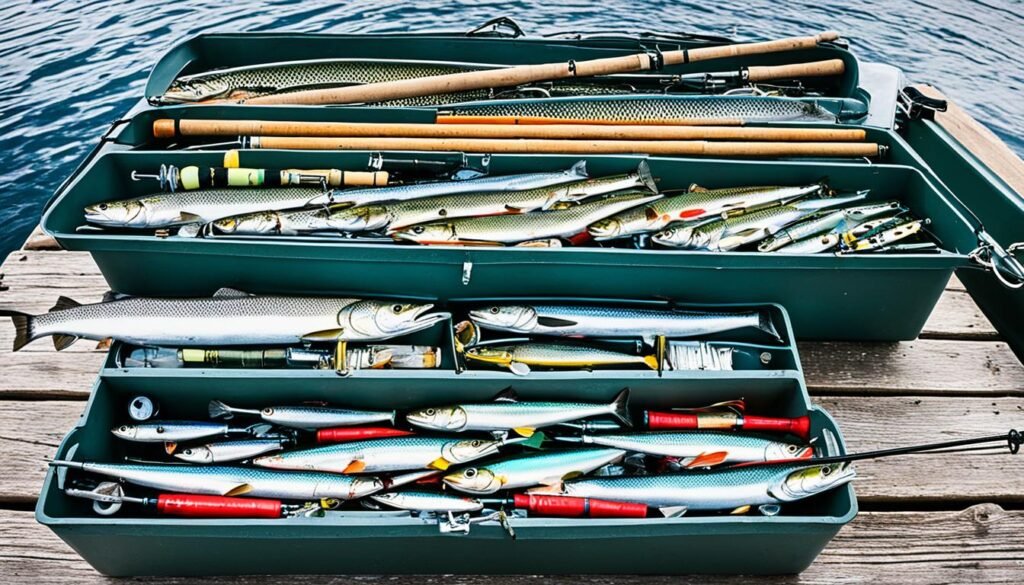
Trophy-Sized Lake Trout:
If you’re specifically targeting trophy-sized lake trout, consider using heavier gear and tackle. This includes upsizing your fishing rod and reel, using a thicker braided line, and opting for a heavier fluorocarbon leader. These upgrades will provide the extra strength needed to handle the larger and more aggressive lake trout.
By equipping yourself with the right gear and equipment, you’ll be well-prepared to tackle the challenges of lake trout fishing and increase your chances of landing that prized catch. Remember, always check local fishing regulations and obtain the necessary licenses before heading out on the water.
Factors Affecting Lake Trout Fishing Success
When it comes to lake trout fishing, several factors can greatly influence your success on the water. One of the most significant factors is the weather conditions you encounter during your fishing trip. The weather can have a direct impact on the behavior and feeding patterns of lake trout, ultimately affecting your chances of catching them.
Cold fronts are notorious for making fish, including lake trout, less active. The drop in temperature and changes in atmospheric pressure associated with a cold front can cause lake trout to become sluggish and less likely to bite. Conversely, a period after a storm can also have an effect on lake trout feeding habits. The disturbance caused by a storm can disrupt the lake’s ecosystem, causing lake trout to temporarily stop feeding as they adjust to the changes.
Another important factor to consider when targeting lake trout is their preferred temperature range. Lake trout tend to thrive in water temperatures between 50 to 60 degrees Fahrenheit. Understanding this temperature preference can help you narrow down your fishing locations and increase your chances of finding active lake trout.
In early spring, as the water begins to warm up, lake trout can be found in shallow water areas. This is because the shallower waters heat up quicker, attracting baitfish and providing a food source for lake trout. As summer arrives and the temperatures rise, lake trout tend to retreat to deeper basins where the water stays cooler. These deeper areas of the lake provide the ideal conditions for lake trout to thrive.
The type of bait you use can also impact your success when fishing for lake trout. Lake trout are known to be opportunistic feeders and can be bait selective at times. It is important to experiment with different bait options to determine what they are currently targeting. Whether it’s using live bait, such as minnows or worms, or artificial lures like spoons or crankbaits, understanding the feeding preferences of lake trout can give you an advantage on the water.

By taking into consideration the various factors that affect lake trout fishing, including the weather conditions and the behavior of the fish, you can strategically plan your fishing trips and increase your chances of a successful catch. Keep in mind that fishing is not an exact science, and being adaptable and observant on the water is key to consistently catching lake trout.
Importance of Location and Depth in Lake Trout Fishing
The success of lake trout fishing is greatly influenced by the location and depth in which anglers choose to fish. Understanding the preferred habitat and feeding patterns of lake trout is essential for targeting this elusive species.
In order to increase your chances of catching lake trout, it is important to identify key fishing locations that are likely to hold these fish. Deep channels, drop-offs, and underwater structures such as points, humps, and rises are all prime areas where lake trout tend to gather and feed.
The depth at which lake trout are found can vary depending on factors such as the season, water temperature, and availability of food sources. By understanding their preferences, anglers can adjust their fishing techniques accordingly to maximize success.
One effective tool for locating lake trout and determining the optimal depth for fishing is a fish locator or depth finder. These devices use sonar technology to provide real-time information on the underwater topography and the presence of fish. By using a fish locator, anglers can precisely target the depth at which lake trout are most active and increase their chances of landing a trophy catch.
Here are a few key points to remember about the importance of location and depth in lake trout fishing:
- The location of deep channels, drop-offs, and underwater structures is crucial for finding feeding lake trout.
- The depth preference of lake trout can vary depending on the season, water temperature, and available food sources.
- Using a fish locator or depth finder can help anglers locate lake trout and determine the optimal depth for fishing.
When venturing out on your next lake trout fishing expedition, be sure to pay close attention to the location and depth of your fishing spots. By targeting the right areas and depths, you’ll greatly increase your chances of landing that prized lake trout.
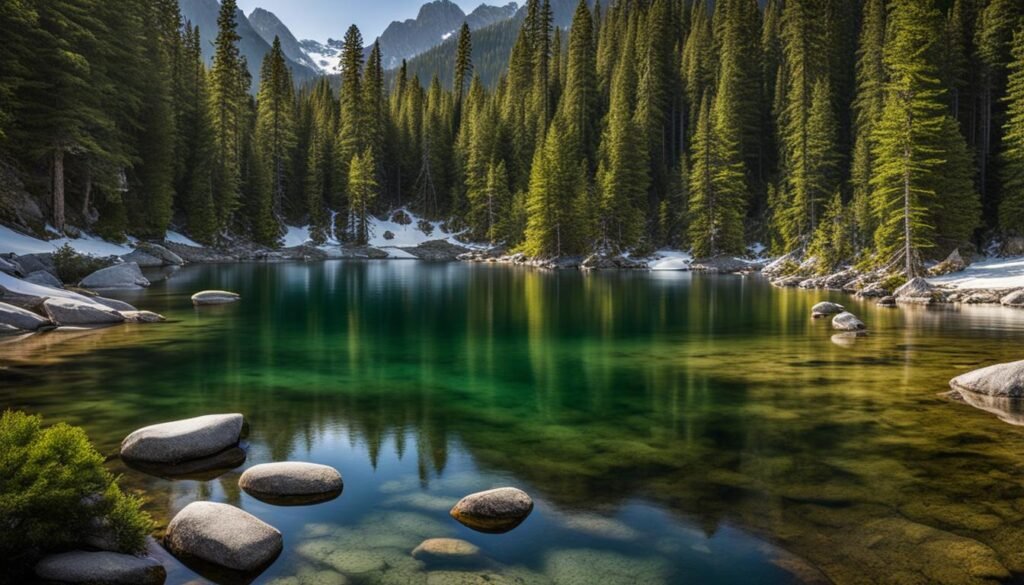
Trolling and Jigging Techniques for Lake Trout Fishing
Trolling and jigging are two popular techniques for catching lake trout. Each technique requires specific baits and movements to attract and entice the fish. By understanding the nuances of trolling and jigging, anglers can increase their chances of success on the water.
Trolling Techniques
Trolling is an effective method for covering a large area and targeting suspended lake trout. Anglers can use a variety of baits such as shad-style crankbaits, spoons, and wide-action crankbaits. These baits mimic the movements of baitfish, attracting lake trout and triggering strikes.
When trolling, it is important to experiment with different presentations and movements of the bait. Varying the speed and depth can help determine what works best on a given day. Anglers should also pay attention to the water temperature and adjust their trolling tactics accordingly.
Jigging Techniques
Jigging is a technique that involves dropping a baited jig to the bottom and then lifting it up and down to attract lake trout. It can be especially effective in enticing lake trout close to the bottom, where they often feed.
For vertical jigging, anglers can use blade baits, Jigging Raps, heavy jigging spoons, and plastics. These baits have a realistic swimming action when jigged properly, making them irresistible to lake trout.
When jigging, it is important to use the right equipment to feel the subtle strikes of lake trout. A sensitive rod with a fast action and a high-quality reel are essential. Anglers should also vary the speed and depth of the jigging motion to find the most effective pattern for the day.
Both trolling and jigging require patience and experimentation. By mastering these two techniques, anglers can enhance their lake trout fishing skills and increase their chances of landing a trophy catch.

Conclusion
Understanding lake trout depth preferences is key to successful fishing. By aligning your fishing techniques and targeting the right depths for each season, you can greatly improve your chances of catching lake trout.
Flexibility is essential when fishing for lake trout. Conditions on the water can change, so it’s important to adapt and try different approaches. Lake trout are known for their aggressiveness, providing an exciting and thrilling fishing experience.
Equipping yourself with the right gear and knowledge is crucial for lake trout fishing. Make sure to use the recommended rods, reels, and lines for the size of lake trout you are targeting. Having a good understanding of the preferred depths for each season will not only increase your chances of success, but also enhance your overall fishing experience.
So, get out there and enjoy the thrill of lake trout fishing. Remember to stay flexible, adapt to changing conditions, and make use of the valuable insights on depth preferences. Happy fishing!
FAQ
What are the best times to catch lake trout?
The best times to catch lake trout are early spring, summer months, and autumn.
What fishing techniques can be used to catch lake trout?
Different fishing techniques such as trolling, casting, and vertical jigging can be used to catch lake trout.
Where can lake trout be found in early spring?
In early spring, lake trout can be found in shallow, warmer water areas where the food chain is active.
Where can lake trout be found in the summer?
In the summer, lake trout can be found in deep basins, relating to points, humps, and bottom transitions.
Where can lake trout be found in the fall?
During the fall, lake trout can be found on spawning shoals in 10 to 20 feet of water.
What gear and equipment are recommended for catching lake trout?
Recommended gear and equipment for catching lake trout include a 7- to 8-foot-long medium or medium-heavy rod, quality reel spooled with 15- to 30-pound-test braided line, and a 14-pound-test fluorocarbon leader material.
How do weather conditions impact lake trout fishing?
Weather conditions such as cold fronts or periods after storms can make lake trout less active or cause them to stop feeding.
How important is the location and depth in lake trout fishing?
The location and depth play important roles in lake trout fishing. Anglers should look for deep channels, drop-offs, and structures such as points, humps, and rises where lake trout are likely to feed.
What are the popular techniques for catching lake trout?
Trolling and jigging are two popular techniques for catching lake trout.
What are the ideal waters for lake trout?
Lake trout are found in the Great Lakes, deep, cold-water lakes in Northern states, certain Western states, and Canada.

